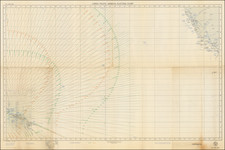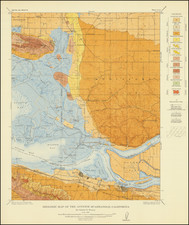A Foundational Map For Supplying Water To Southern California
Rare early irrigation map of the Los Angeles Basin and contiguous parts of San Bernardino County, published by William Hammond Hall, California State Engineer in 1888.
The present map is the Outline map which provides the overview for William Hammond Hall's monumental 12 sheet mapping of the Southern California watershed, the single most important mapping of Southern California during its first major economic boom.
On this map, Hall identifies the primary watershed rivers and creeks that feed out of the San Gabriel and San Bernardino Mountains and create the watershed of the San Bernardino Valley, San Gabriel Valley, San Fernando Valley and the Coastal Plain.
The map was intended to accompany Hall's Report on Irrigation and Water Supply. In the same time frame, Hall produced a massive 12 sheet map covering the same region on a scale of 1.5 inches per mile for the California State Department of Engineering, which is referenced in the Note at the bottom right corner.
William Hammond Hall
As noted by the Online Archive of California:
William Hammond Hall served as California's first State Engineer from 1878 to 1889. During those years, Hall surveyed and reported on the state's water resources. . . Hall's examinations still serve as the most extensive study of California's water systems to date, the scale of which, considering the fiscal situation of California's state government, is likely never to be matched.
* * *
In 1878 Governor William Irwin appointed Hall to the newly created post of State Engineer. There Hall was re-appointed four times until his resignation in February 1889. Two major causes motivated the California Legislature to create the position of State Engineer. One was the long and devastating drought that had virtually destroyed the cattle industry in Southern California and drove countless small and marginal farmers off their land due to lack of adequate irrigation. Additionally, floods in Northern California were wreaking havoc, frequently resulting from improper drainage and a lack of adequate flood control measures.
The Legislature of 1878 charged the State Engineer with investigating the problems of irrigation, the condition of drainage lines, and the improvement of river navigation. . .
Hall's first action as State Engineer was to send out parties to investigate various rivers and the lands surrounding them. These parties, led by assistant engineers whose names would eventually gain fame in their own right (Grunsky, Boschke, Schuyler, and Mendell to name a few), continued throughout Hall's tenure to supply the State with vital information regarding California's water resources. . .
Hall's suggestions to the Legislature focused on his opinion that the State must take it upon itself to regulate California's water resources. Hall felt that the Legislature should first survey the extent and nature of existing water rights and then take on the role of issuing water privileges. He recommended that the lawmakers and the courts carefully study and provide for a solution to the problems presented by the competing interests of riparian proprietors and appropriators. During his tenure as State Engineer, Hall supported the organization of irrigation districts as the best means of financing and regulating irrigation works. Hall's reports to the Legislature all included brief histories of California's water system, for he felt that only through understanding how the state's systems came into being could lawmakers intelligently plan for the future. . .
By 1881 Hall and his assistants had conducted massive amounts of research, which were used not only to make recommendations for action to the Legislature but also would later go into the publication of Hall's landmark work on irrigation. In 1881 Hall asked the Legislature for $50,000 to complete his research. The Legislature gave him $20,000, an insufficient amount which forced Hall to continue his research by paying for much of it out of his own pocket. By the end of 1882 Hall was under attack by members of the Legislature and the press, a matter which he attributed to his stance against the Drainage Act of 1880. Somehow, despite his adversaries' efforts Hall managed to garner enough funding to produce and publish two volumes of his work on irrigation. Then in 1889 the Legislature voted to abolish the office of State Engineer and instead make the State Mineralogist the ex-officio State Engineer for the next two years. With his position abolished, Hall offered to stay on as an unpaid consultant in order to collect the final data for the rest of his irrigation study, needing only $6,000 for staff and expenses. He was denied, however, and the labor which he had put into the final two volumes of his work went to waste
* * *
. . . [W]hat Hall [left] to California is impossible to measure. His emphasis on planning based on thorough technical observations would serve as a rule of thumb for those who would later build upon Hall's beginnings and construct the State's revolutionary water systems. . .









![[ Coronado Beach Broadsheet ] Map of Coronado Beach San Diego, California / Coronado Beach and Surrounding Country](https://storage.googleapis.com/raremaps/img/small/99912.jpg)

![[Collection of 10 manuscript charts and maps depicting the west coast of North America from Monterey, California, to just north of Salisbury Sound, Alaska.]](https://storage.googleapis.com/raremaps/img/small/98898.jpg)
![[Northern San Diego County] Escondido Quadrangle](https://storage.googleapis.com/raremaps/img/small/83567.jpg)

